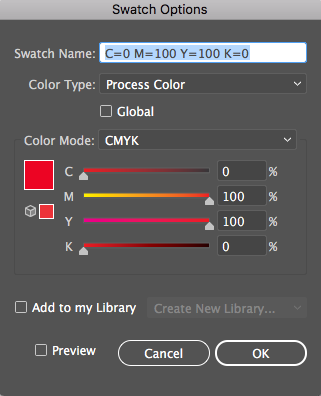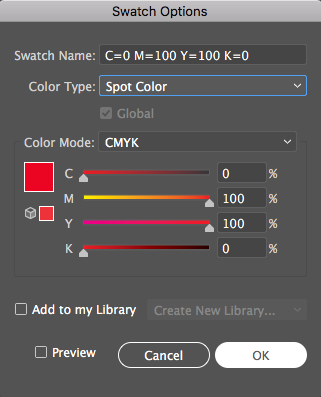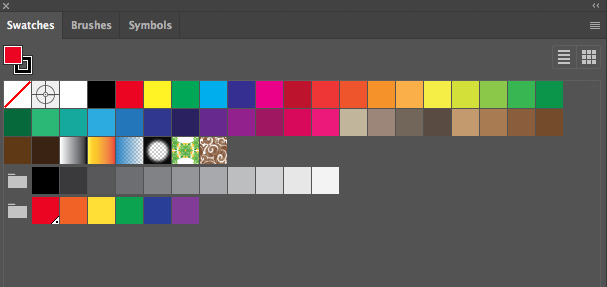- Home
- Illustrator
- Discussions
- Illustrator Swatch panel (Colour Type menu - Proce...
- Illustrator Swatch panel (Colour Type menu - Proce...
Copy link to clipboard
Copied
Hi,
When I'm in the Illustrator Swatches panel, I can double click on an existing CMYK colour swatch and view options for it in the Swatch Options panel.
The Swatch Name comes up as the relevant CMYK values and the 'Colour Type' drop down menu defines it as a Process Colour.
Colour Mode is CMYK. Everything is as expected.
Under the 'Colour Type' dropdown menu, I can change 'Process Colour' to 'Spot Colour.'
When I do this, Colour Mode remains set to CMYK (although can be changed to Grayscale, RGB, HSB, Lab or Web Safe RGB)
I find this odd, as I wouldn't normally think of any of the above as being directly connected with choosing Spot Colours
(other than converting from Process colour to Spot colour)
When I changed the Colour Type to Spot Colour I assumed I would see some sort of conversion mechanism, offering to try and convert the CMYK colour to the nearest colour book colour e.g. a Pantone colour.
Or perhaps a list of the colour book types available from the Swatches Panel corner menu > Open Swatch Library > Colour Books.
(I realise these options bring up a new window full of the selected Color Book's colours along with the associated ink names and these can be dragged into the main Swatch panel)
Having made the change from a CMYK swatch into a Spot Colour swatch via the Color Type dropdown menu, I can then 'OK' this window to close it.
The Swatches panel displays the selected (previously CMYK) swatch but it now has a circular icon to indicate it's a Spot Colour. So I would assume Illustrator now regards this colour as a Spot Colour and no longer a Process Colour.
However when I move my mouse over it, or double click to open the Swatch Options, the Swatch in question is still referred to by it's CMYK colour values, and looks exactly as it did previously.
If the colour has indeed been changed from a CMYK swatch to a Spot Colour swatch, I have no way of knowing which book the Spot Colour is from in order to communicate this to a commercial printer.
I know how to create a named Spot Colour Swatch and how to access colour books from which to select colours and add them to the Swatches panel
i.e. Swatches Panel corner menu > Open Swatch Library > Colour Books.
I'm unclear as to why we can select and edit a CMYK Swatch, change its 'Colour Type' setting to a Spot Colour, but for there to be no way to identify which specific spot colour it now apparently is.
Thanks for any assistance - maybe there's something obvious I'm missing here and apologies if so.
Kind regards,
John
 1 Correct answer
1 Correct answer
I'm still unclear on what is actually being done when I make this change in the Swatches panel.My previously CMYK colour…a CMYK swatch (a red colour in this case)…is now regarded by Illustrator as a Spot colour…So some kind of change has taken place - from CMYK to Spot.
Right. 100M, 100Y. That's as "red" as red gets in CMYK process printing: Magenta and Yellow printed as solids (no tone dots).
It's a prime example of what I said about process-to-spot not being the exacting 1:1 correspondence many
...Explore related tutorials & articles
Copy link to clipboard
Copied
You're basically confusing color model (RGB, CMYK) and color type (Process, Spot).
When I changed the Colour Type to Spot Colour I assumed I would see some sort of conversion mechanism, offering to try and convert the CMYK colour to the nearest colour book colour e.g. a Pantone colour.
As I recall, back in the day, FreeHand could indeed "match" a color defined in CMYK to the ostensibly "nearest" Pantone ink. But that is not a simple 1:1 data match. Just as there are many ways to "convert" a given RGB color to CMYK values, spot colors are not limited to those in the various "color books" from ink vendors. The actual color (and density, and reflectivity, and chroma, and…) is simply a function of what ink is physically loaded into the press (or thread loaded onto the embroidery machine, or sign vinyl loaded into the cutter, or stained glass to be bought and chipped into shape, or…).
A spot color in drawing software is simply a color that is sent to its own grayscale plate when printed as color separations. The "color" of that plate is effectively nothing but a text string label applied to that plate.
For example, there is nothing preventing my mixing half a pint of One Shot Imitation Gold with a quarter pint of One Shot Fire Red (although I wouldn't recommend it) with which to letter a customer's race car. To create my pounce pattern in my drawing software, I would define that as a spot color named Muddy Orange. For production purposes, I really wouldn't care one whit what it looked like on the monitor, because I would know it's simply a label on an extra separation plate, and changing the displayed color of that Spot Swatch to literally any color would have no effect whatsoever on which paint can I dip my brush into.
But in order for me to present a reasonable approximation of the design to the customer, the interface of the software has to provide me some means by which to "mix" a representation of Muddy Orange, using one of the program's color models (RGB or CMYK). The program doesn't have a color model based on One Shot Lettering Enamel, and even if it did, the RGB monitor could not accurately render it. The most accurate "match" would have to be a subjective judgement on my part.
Color Swatches set up as Spot colors are not just for offset printing. Drawing software is used across many graphics industries. Even though, for example, the CMYK color model is based upon standardized offset printing process inks and Pantone Spot Inks are intended for offset printing, a drawing software does not accurately "match" Pantone Spot inks with the CMYK values you use to define them—which are in turn converted to RGB anyway, in order to display on your monitor.
Even if "color management" (color calibration) were perfect (which it's not), you still couldn't accurately display Pantone Spot inks in Illustrator, because Illustrator's Spot Swatches do not provide for color-specific opacity.
For example, screen printing spot color inks are somewhat translucent (depending partly on how thickly they are laid down), but much more opaque than offset printing spot color inks. 100% overprinting of different colored inks is a very common practice in screen printing. A most obvious example is overprinting white highlights onto darker inks or darker substrates.
So suppose Illustrator did provide automatic Spot Swatch "matching" to the "nearest" colors in both Pantone's and NazDar's color books. Set up a project for screen printing, define the Spot Swatches as NazDar inks. Build your layers. Then turn on Illustrator's Overprint Preview and see that (among other things) your overprinting opaque white Spot Ink objects completely disappear.
JET
Copy link to clipboard
Copied
Hi JET,
Thanks very much for getting back to me and for your very thorough answer.
I'm still unclear on what is actually being done when I make this change in the Swatches panel.


Above are screenshots from the Swatch Options having double clicked a CMYK swatch (a red colour in this case)
The panel itself uses the term: "Color Type" and lets you select from either Process or Spot (as above)
And below it uses the term "Color Mode" and lets you choose from CMYK / RGB / Grayscale etc etc etc
When I click OK, the window closes and I see this.

My previously CMYK colour (red at lower left) is now regarded by Illustrator as a Spot colour according to the Spot Color icon which has appeared in its lower right corner.
So some kind of change has taken place - from CMYK to Spot.
Copy link to clipboard
Copied
I'll try to simplify.
Process Color is made in the printing process by the combination of the four colors in CMYK. So in Illustrator, the CMYK colors you are looking at are representative of that 4 color process.
Spot Color is where a single specific color is used from a chart of Pantone inks. So the colors created on the printed page are not made by combining layers of colors, but rather by applying 1 specific color.
The big difference in the printing process is that using just CMYK, you can replicate pretty much anything with just those 4 colors. But when using spot color, every single color you want in your final image has to be run as a single color pass. So Yellow would be one color pass, Red would be another, Blue another, Green another, Orange another, Pink another, Purple another, and so on and so on.
So the variations you see in your swatches when you go back and forth between spot and process are because of what the colors represent in the print world. So your best bet is to just stick with process and forget spot is even there unless you are working with a printer who specifically requests it.
Copy link to clipboard
Copied
Hi Daniel,
Thanks very much for your reply, much appreciated.
I've previously used specific spot colours originating from Pantone books in addition to four colour process print jobs.
And I had previously assumed spot colours could originate from colour books only.
What I wasn't appreciating was the significance of the single colour pass application to the definition of a spot colour.
If I'm understanding correctly, you could (for example) mix a colour from Cyan, Magenta, Yellow and Black inks (i.e. those normally used for four colour process printing) and create a specific colour.
This specific colour mix could then be applied as a single colour pass, which, because it's a single colour pass, would still meet the definition of spot colour (i.e. without the involvement of Pantone inks or any other manufacturer of inks that sit outwith the CMYK colour gamut.)
An example of such a situation I think might be a background image composed of just black ink printed on white paper.
And an additional element (e.g. a shape or a word or whatever) printed on top in the premixed colour as a single application.)
Any thoughts welcome and thanks again.
Kind regards,
John
Copy link to clipboard
Copied
welshonemillion wrote
If I'm understanding correctly, you could (for example) mix a colour from Cyan, Magenta, Yellow and Black inks (i.e. those normally used for four colour process printing) and create a specific colour.
This specific colour mix could then be applied as a single colour pass, which, because it's a single colour pass, would still meet the definition of spot colour (i.e. without the involvement of Pantone inks or any other manufacturer of inks that sit outwith the CMYK colour gamut.)
That is exactly what the Focoltone system was supposed to offer, mixtures of standard CMYK inks into a solid spot ink as well as the same colours, but made with 4 colour printing.
I am not sure if there is any printer that still uses that system, but the Focoltone libraries are still available in Illustrator as Global Process colours.
Copy link to clipboard
Copied
That's not really it. You're reading too much into the CMYK value that is there for spot colour. The essential things about spot colours is that they come in a bucket and get put on the press. They come from somewhere, but it's the press operator's job to give the right ink for the colour you choose. If you choose from a Pantone book, the press operator can buy or mix some Pantone coloured ink. If you make up a spot colour called Sky Blue Pink, the press operator will call you and ask (politely or not) what colour ink you actually want to use. The press operator will NOT use your CMYK mix.
So, why is there a CMYK, or Lab, or RGB value for the spot colour you define? Simple. You want to be able to see it on screen. So that colour tells Illustrator how to show your spot colour (or some approximation to it, or something completely different if you want) on screen. It's also used if you print to a desktop printer.
Copy link to clipboard
Copied
Thanks for the clarification here - much appreciated.
Copy link to clipboard
Copied
I'm still unclear on what is actually being done when I make this change in the Swatches panel.My previously CMYK colour…a CMYK swatch (a red colour in this case)…is now regarded by Illustrator as a Spot colour…So some kind of change has taken place - from CMYK to Spot.
Right. 100M, 100Y. That's as "red" as red gets in CMYK process printing: Magenta and Yellow printed as solids (no tone dots).
It's a prime example of what I said about process-to-spot not being the exacting 1:1 correspondence many think it to be. It is also simply not true that "all colors can be made by mixing process C, M, Y, and K." Far from it. There is a whole world of colors that cannot be "matched" in 4-color process. That's one reason why spot inks exist. Examples:
- Pantone 185C is a very common choice for a "very red" red. One could say it is actually "redder" than the "reddest" you can mix in CMYK process inks. How? Because there is more to "color" than just hue (yellow, red, purple, etc., etc.) There is reflectance. Chroma. Even luminescence. Pantone's Spot to Process color guides specify significantly less than 100% of M and Y in order to simulate 185C. And that mix falls far short.
- You can try all varying percentages of Y and M and you are never going to get school bus yellow.
- And most of all, you are never, ever going to get "sky blue" from any tint of Process Cyan, because of the four process inks, Cyan is the weakest.
When designing for print, forget "color." Think "inks."
What's being done is exactly what I said: Defining a Swatch as Spot simply tells the program to create a separate grayscale color channel (color separation plate) labeled by that Swatch's name. That's it.
Suppose your project is a brochure to be printed on a commercial sheet-fed offset press. So you set it up as CMYK (four inks).
In order to print that file, it has to be color separated; imaged as a set of individual films (or plates); one for each ink. Software first creates one image (channel) for each ink:
- An image for Cyan ink
- An image for Magenta ink
- An image for Yellow ink
- An image for Black ink
Did you catch that? Each image is just a grayscale image. There is no color involved.
Each of those channels is then individually screened by the Raster Image Processor into a bitmap; an array of tiny solid black dots. That's what actually gets printed to the film (as a negative) or directly to the plate (as a positive).
Again, catch that: Now there are not even any grayscale tones. Each channel has just become a bitmap; a 1-bit image; it's all just "pixel on" or "pixel off." An offset press doesn't print "tones" of ink. It either prints "ink" or "no ink."
But suppose the client's logo color specification is a particular spot color, Pantone 185, and the client wants it that color; not a mere approximation of it. (The four color process brochure has now become "process plus 1.")
So you define a new Swatch, tediously adjusting whichever color mode of sliders and fields you want, calling upon all the extraordinarily sensitive artistic discernment you can muster in order to simulate on your monitor what you think looks as precisely close as possible to the color of Pantone 185 ink.
But fact is, as soon as you tell the program "I want this to be a Spot Swatch", the color settings you've been sweating blood over really mean absolutely nothing. Neither the program nor the pre-press imaging process is going to "mix" the ink for you. The pressman is going to pull it off the shelf and load it into the inkwell, just like he does with Cyan, Magenta, Yellow, and Black process inks.
By setting the Color Type to Spot you've just told the program, "This Swatch represents another separate ink. It is not to be color-separated into CMYK. So anything colored with this Spot Swatch shall not appear on the C, M, Y, or K plates. Everything colored with this Swatch is imaged in one additional single grayscale channel which is merely labeled 'Pantone 185.'"
So when the printing house receives the file he images it as color separations, just as before, but this time gets 5 plates, again one for each ink:
- An image for Cyan ink
- An image for Magenta ink
- An image for Yellow ink
- An image for Black ink
- An image for Pantone 185 ink
Here's the thing:
You could have "mixed" the displayed color of the "Pantone 185" Spot Swatch using 100M and 100Y (as you did, and as I would). It doesn't matter one whit whether that is what Pantone Inc recommends as the "best" CMYK simulation for that Pantone ink.
In fact, you could name that Swatch "Pantone 185" but edit its color to look like my Muddy Orange on the monitor. It would not change how the extra separation plate images at all.
You could also have forgotten to name that Swatch "Pantone 185." If you had, the program would have left its name "C=0 M=100 Y=100 K=0", and functionally, that also wouldn't change a thing. But you'd probably get a call from the printing house asking, "What ink do you intend to use for this spot color. Or did you make it a spot Swatch by mistake?"
You could go back and rename that Spot Swatch "Peter Pan One Eighty Five" and that wouldn't matter one whit, either. The spot color that prints is simply a matter of what color ink the pressman loads into the inkwell for that separation plate.
There is no programmagical "link" between how you color your on-screen simulation of a Spot Swatch and the ink that the pressman loads. It's just a piece of information that needs to accompany the job.
JET
Copy link to clipboard
Copied
Thanks again for your time JET, this clarifies.
Sent from my iPhone
Find more inspiration, events, and resources on the new Adobe Community
Explore Now